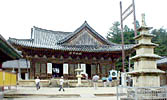  Located in Youngchwi-san, Tongdo-sa is not only a temple but also a museum
holding 19 provincial treasures and 794 culture assets designated by South Gyeongsang Province. The temple
grounds contain 35 buildings and 14 hermitages are nearby. This temple is one of the three major temples
in Korea called the Sambosachal temples (the others are
Haein-sa and
Songgwang-sa).
It was built in 646.
Located in Youngchwi-san, Tongdo-sa is not only a temple but also a museum
holding 19 provincial treasures and 794 culture assets designated by South Gyeongsang Province. The temple
grounds contain 35 buildings and 14 hermitages are nearby. This temple is one of the three major temples
in Korea called the Sambosachal temples (the others are
Haein-sa and
Songgwang-sa).
It was built in 646.
The temple's name of Tongdo has three meanings: the mastery of Buddha's
teaching in order to salvage humanity, Youngchwi-san surrounding Tongdo-sa looks much like Mt. Youngchwi
in India where Buddha preached, and everyone who wants to become a monk (meaning bulbo) must pass
through the Geumgang Gyedan (the power breaks the worries of Vajara Sutra). Tongdo-sa
was erected by Jajangyulsa in 646. He brought Buddha's skull, a molar, and one of his poems from
China.
 
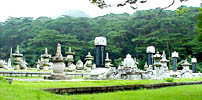 

Jajangyulsa also divided Buddha's relics into three groups and buried them under Hwangryong-sa pagoda
near Tongdo-sa's stairs. These stairs are called Geumgang Gyedan. Constructed during the reign of Queen
Seondeok, these stairs have numerous stories related to them. One story tells that large snakes and toads
were put in stone box to prevent curious people from looking into nearby stone bell. During Japanese invasion
of Korea, Uiseung-jang monk Samyeong divided several relics among two big and small boxes and sent them to
monk Seosan in Geumgang-san.
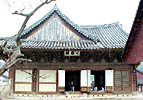  Daeung-jeon, the main hall of Tongdo-sa, has no Buddha images but an altar,
very unusual for a Buddhist temple. The temple is also famous for Guryongji (a small pond dividing
Yaksa-jeon and Josa-jeon behind Daeung-jeon) and Yonghyeol-am (located 100 meters to the north of
Mupung-gyo at the temple's entrance), all of which have interesting legends.
Daeung-jeon, the main hall of Tongdo-sa, has no Buddha images but an altar,
very unusual for a Buddhist temple. The temple is also famous for Guryongji (a small pond dividing
Yaksa-jeon and Josa-jeon behind Daeung-jeon) and Yonghyeol-am (located 100 meters to the north of
Mupung-gyo at the temple's entrance), all of which have interesting legends.
  According to legend, the location of Tongdo-sa was once a big lake where dragons
lived. One day Jajangyulsa (the founder of the temple) recited a magic formula and Buddhist scriptures
to ask the dragons to leave the lake, but they refused to do so. He wrote the Chinese character for fire on
a sheet of paper and and threw it into the sky and simultaneously splashed the water of the lake with his
long stick. All the water began to boil.
According to legend, the location of Tongdo-sa was once a big lake where dragons
lived. One day Jajangyulsa (the founder of the temple) recited a magic formula and Buddhist scriptures
to ask the dragons to leave the lake, but they refused to do so. He wrote the Chinese character for fire on
a sheet of paper and and threw it into the sky and simultaneously splashed the water of the lake with his
long stick. All the water began to boil.
Three dragons could not tolerate the heat and tried to escape. They flew into a cliff which still retains
the stain of their blood (Yonghyeol-am means "dragon blood rock"). Five dragons fled into
a southwest valley beyond the temple, which is now called Oryonggok ("five dragon valley"). The
last dragon went blind and vowed to Jajangyulsa that he would guard the temple forever and so was
allowed to stay in what is now called Guryongji.
 
 
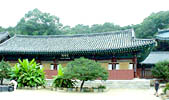
Location: Habuk-myeon
Information: (055) 382-7182
Hours: 9:00 - 18:00 (Nov.-Feb. until 17:00)
Admission:
Adults: 2,000 won (Groups: 1,500 won)
Youths: 1,500 won (Groups: 1,200 won)
Children: 1,000 won (Groups: 800 won)
Group: 30 people or more
[Museum Admission]
Adults: 2,000 won (Groups: 1,500 won)
Students, Seniors: 1,000 won (Groups: 700 won)
Children: Free (Groups: 700 won)
Group: 30 people or more
Directions: Gyeongbu Expressway -> Tongdo-sa Interchange
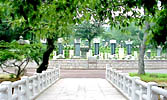 
 

(For more sites of Tongdo-sa, please see page 2.)
|











